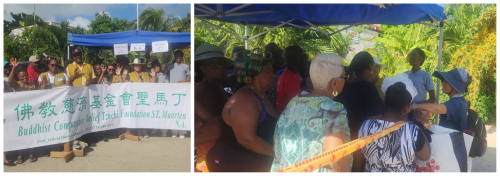 CAPE BAY:--- The Buddhist Compassion Relief Tzu Chi Foundation St. Maarten carried out its 26th Cay Bay food relief distribution on December 14, 2025, marking two years and two months of uninterrupted monthly assistance to the community and concluding its Cay Bay relief efforts for the year.
CAPE BAY:--- The Buddhist Compassion Relief Tzu Chi Foundation St. Maarten carried out its 26th Cay Bay food relief distribution on December 14, 2025, marking two years and two months of uninterrupted monthly assistance to the community and concluding its Cay Bay relief efforts for the year.
The distribution was supported by 16 volunteers, including one Commissioner, five Training Commissioners, three Tzu Chi volunteers, and seven community volunteers, reflecting continued collaboration and community involvement. During the activity, 90 families received essential food items consisting of a 22-pound bag of rice, one liter bottle of cooking oil, two packs of pasta, two packs of dry peas, and Christmas butter cookies.
Although many recipients are often reserved about sharing their personal circumstances, several spoke about the impact of the assistance, noting that even a small amount of food can make a meaningful difference, particularly for families with children. One young Haitian mother explained that the monthly food support helps her children and eases her worries, especially at the end of the month when rent is due, and she described the emotional stress of struggling to meet rental payments while expressing gratitude for the consistent support. Another recipient shared that many families in the Cay Bay area live in extreme poverty and explained that he regularly collects food on behalf of a neighbor who is unable to leave his home due to health conditions. An elderly recipient expressed sincere appreciation, stating that he is very thankful that Tzu Chi volunteers continue to bring food every month and that the community truly values this care.
Other recipients shared that life in Cay Bay is difficult for many residents, with some affected by unemployment and others by low incomes that make it hard to pay utility bills. Seniors face challenges related to low pensions and illness, while many parents worry daily about being able to provide their children with their next meal. Despite these hardships, recipients contributed Bamboo Bank donations totaling US $125.80, reflecting gratitude and a spirit of giving back.
Throughout 2025, Tzu Chi St. Maarten provided sustained monthly assistance to the Cay Bay community, distributing a total of 1,355 bags of rice, 1,355 bottles of cooking oil, 1,859 packs of pasta, 1,859 packs of dry peas, and 90 Christmas cookie packages. Over the course of the year, 193 volunteers were involved, 1,364 families benefited from the programe, and a total of 4,092 family members were supported.
As the final Cay Bay relief distribution of 2025, many recipients expressed hope that Tzu Chi will be able to continue supporting the community in 2026. The Tzu Chi team reflected on the ongoing needs in Cay Bay and stated that it remains committed to carefully evaluating how best to continue providing compassionate and meaningful assistance in the coming year.






 PHILIPSBURG:--- Under the banner Live Love Smile 2025, the staff of The Windward Islands Bank (WIB) once again stepped outside the walls of banking and into the heart of the community during the weekend of December 5–7. With colour, care, and compassion, WIB employees united to deliver eight impactful community projects that touched the lives of children, seniors, vulnerable youth, and families across St. Maarten.
PHILIPSBURG:--- Under the banner Live Love Smile 2025, the staff of The Windward Islands Bank (WIB) once again stepped outside the walls of banking and into the heart of the community during the weekend of December 5–7. With colour, care, and compassion, WIB employees united to deliver eight impactful community projects that touched the lives of children, seniors, vulnerable youth, and families across St. Maarten. Some legends are born; others return. An old fisherman became the heart of Christmas on a small Caribbean Island. Old Man Bramble left his Island as a boy. He returned as a Legend of Light for the World. His lantern became a symbol reminding us of faith, kindness, and togetherness. A Christmas story that asks you to walk gently and tells you that you will never walk alone. Not ever.
Some legends are born; others return. An old fisherman became the heart of Christmas on a small Caribbean Island. Old Man Bramble left his Island as a boy. He returned as a Legend of Light for the World. His lantern became a symbol reminding us of faith, kindness, and togetherness. A Christmas story that asks you to walk gently and tells you that you will never walk alone. Not ever.





